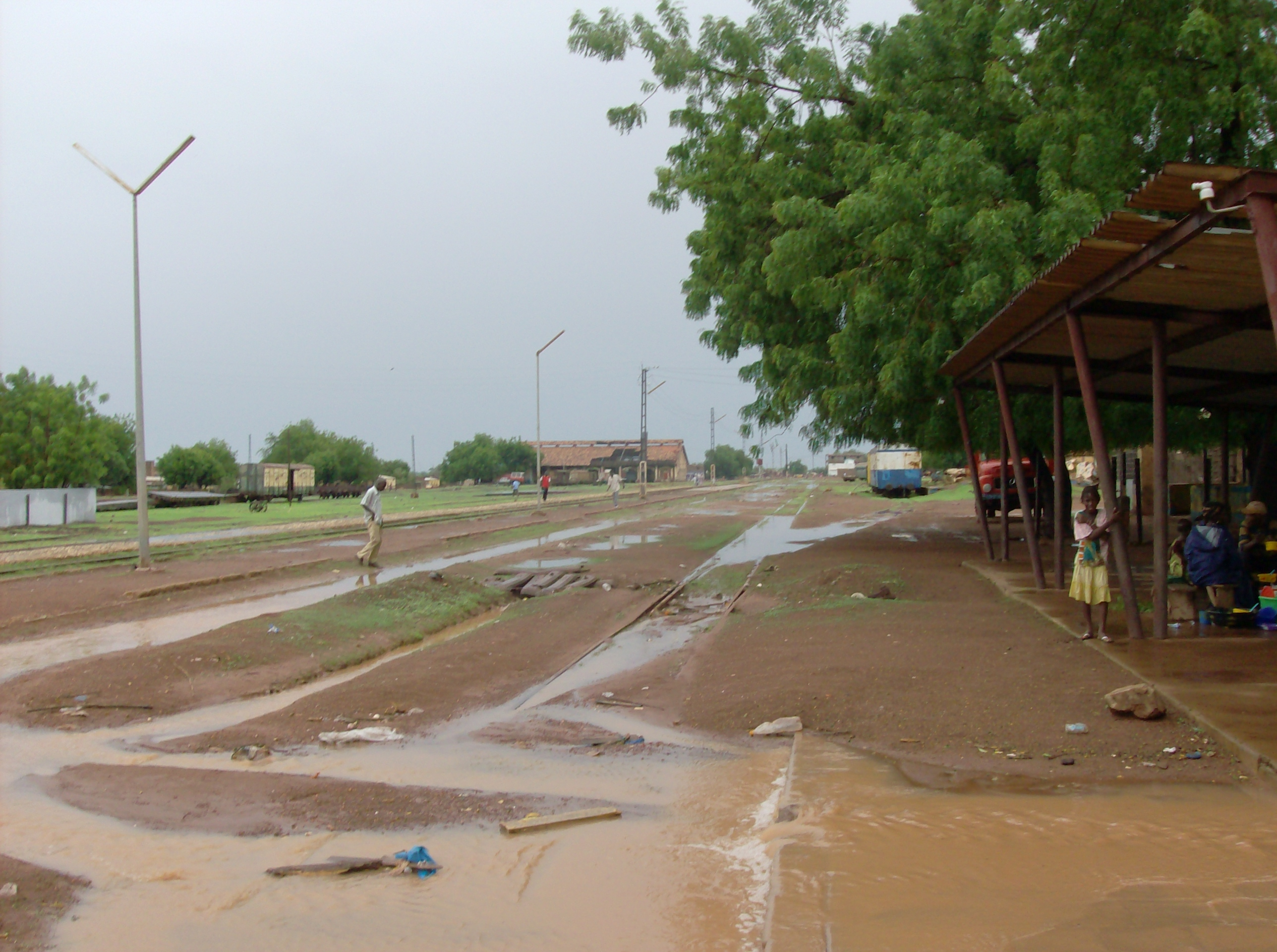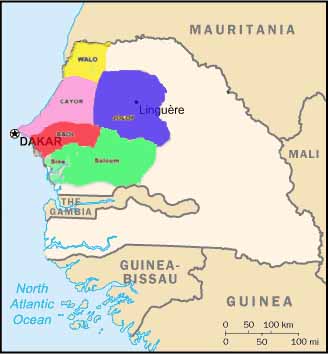|
Tambacounda
Tambacounda ( ar, تامباكوندا; Wolof: Tambaakundaa ) is the largest city in eastern Senegal, southeast of Dakar, and is the regional capital of the province of the same name. Its estimated population in 2007 was 78,800. Geography Tambacounda is situated on the sparsely populated sahélien plains of eastern Senegal. Nearby towns include Madina Maboule, Koukari, Yoro Sankoule, Sambadian, Djidje Kounda, Afia Seno, Saare Boylii and Kanderi Niana. Climate Tambacounda has a tropical savanna climate ( Köppen ''Aw''), bordering upon a hot semi-arid climate (''BSh''). Like most of West Africa, the area has two seasons, the rainy season from June to October, characterized by heat, humidity and storms, and the sweltering, rainless dry season from November to May. The average precipitation is . Population and culture Between the censuses of 1988 and 2002, Tambacounda grew from 41,885 to 67,543 inhabitants. In 2007, according to official estimates, the population reached 7 ... [...More Info...] [...Related Items...] OR: [Wikipedia] [Google] [Baidu] |
Tambacounda Region
Tambacounda, formerly known as ''Sénégal Oriental'', is a region of Senegal. It used to be part of the Mali Empire before the borders were created to separate Mali from Senegal. Tambacounda is physically the largest of Senegal's 14 regions, but is sparsely populated and its economy lags behind the rest of the country. The department of Kédougou was separated from Tambacounda in 2008, and became a separate region. Departments Tambacounda region is divided into 4 departments: * Bakel Département * Goudiry Département * Koumpentoum Département * Tambacounda Département Geography Tambacounda is traversed by the northwesterly line of equal latitude and longitude. Culture Tambacounda is famous for its rich djembe and dance culture and heritage. Some of the greatest djembe masters from Segu, Mali came to Tambacounda in the mid 1900s, bringing with them their history, knowledge, and secrets of the djembe. Its official language is French, but Wolof is more widely spoken in Sén ... [...More Info...] [...Related Items...] OR: [Wikipedia] [Google] [Baidu] |
Abdoulaye Diakité
Abdoulaye Diakité (December 15, 1950 – January 8, 2018) was an influential djembe master drummer and teacher from Tambacounda, Senegal. He was the lead djembe player of the National Ballet of Senegal for 18 years before emigrating to the United States. Early life Born in Tambacounda in 1950, Diakité was a member of the Bamana ethnic group from Mali. The Bamana are a tribe of the Malinke (mainly in Mali and Senegal) that resisted modernization and Christian missionary efforts. Diakité began drumming at the age of seven. Throughout his youth, Diakité was known for his natural ability on the djembe drum. For many years, he studied with his teacher Suncaru Jara in Tambacounda. Jara's teacher was Chebleni Traore whose teacher was Numuni Traore, the first master drummer to take the djembe out of Bamana secrecy, igniting its diaspora. At age 16, Diakité played at a festival in Tambacounda that would dramatically change his life. The National Ballet of Senegal was looking for a ... [...More Info...] [...Related Items...] OR: [Wikipedia] [Google] [Baidu] |
Roman Catholic Diocese Of Tambacounda
The Roman Catholic Diocese of Tambacounda ( la, Tambacundan(us)) is a diocese located in the city of Tambacounda in the Ecclesiastical province of Dakar in Senegal. History * August 13, 1970: Established as Apostolic Prefecture of Tambacounda from the Diocese of Kaolack and Diocese of Saint-Louis du Sénégal * April 17, 1989: Promoted as Diocese of Tambacounda Special churches * The cathedral is Cathédrale Marie Reine de l’Univers in Tambacounda, which is located in the Medina Coura neighborhood of the town. Leadership * Prefect Apostolic of Tambacounda (Roman rite) ** Fr. Clément Cailleau, C.S.Sp. (1970.08.13 – 1986.04.24) * Bishop A bishop is an ordained clergy member who is entrusted with a position of authority and oversight in a religious institution. In Christianity, bishops are normally responsible for the governance of dioceses. The role or office of bishop is ...s of Tambacounda (Roman rite) ** Bishop Jean-Noël Diouf (1989.04.17 – 2017.08.05) ** Bis ... [...More Info...] [...Related Items...] OR: [Wikipedia] [Google] [Baidu] |
Tambacounda Department
Tambacounda Department is one of the 45 departments of Senegal, and one of the four making up the Tambacounda Region. It formerly covered an area of 20,328 km² and in 2013 had an estimated population of 283,769. However in 2005 it was reduced in size to create the new Koumpentoum Department. The department has one only urban commune, that of Tambacounda Tambacounda ( ar, تامباكوندا; Wolof: Tambaakundaa ) is the largest city in eastern Senegal, southeast of Dakar, and is the regional capital of the province of the same name. Its estimated population in 2007 was 78,800. Geography Tam .... The rest of the department is divided into three arrondissements, which in turn are divided into rural districts (''communautés rurales''): *Koussanar Arrondissement: ** Koussanar ** Sinthiou Malème *Makacolibantang Arrondissement: ** Makacolibantang ** Niani Toucouleur ** Ndoga Babacar *Missirah Arrondissement: ** Dialacoto ** Missirah ** Néttéboulou Historic Sites [...More Info...] [...Related Items...] OR: [Wikipedia] [Google] [Baidu] |
Senegal
Senegal,; Wolof: ''Senegaal''; Pulaar: 𞤅𞤫𞤲𞤫𞤺𞤢𞥄𞤤𞤭 (Senegaali); Arabic: السنغال ''As-Sinighal'') officially the Republic of Senegal,; Wolof: ''Réewum Senegaal''; Pulaar : 𞤈𞤫𞤲𞤣𞤢𞥄𞤲𞤣𞤭 𞤅𞤫𞤲𞤫𞤺𞤢𞥄𞤤𞤭 (Renndaandi Senegaali); Arabic: جمهورية السنغال ''Jumhuriat As-Sinighal'') is a country in West Africa, on the Atlantic Ocean coastline. Senegal is bordered by Mauritania to the north, Mali to the east, Guinea to the southeast and Guinea-Bissau to the southwest. Senegal nearly surrounds the Gambia, a country occupying a narrow sliver of land along the banks of the Gambia River, which separates Senegal's southern region of Casamance from the rest of the country. Senegal also shares a maritime border with Cape Verde. Senegal's economic and political capital is Dakar. Senegal is notably the westernmost country in the mainland of the Old World, or Afro-Eurasia. It owes its name to ... [...More Info...] [...Related Items...] OR: [Wikipedia] [Google] [Baidu] |
List Of Cities In Senegal ...
This is a list of cities in Senegal organised by population. It includes all cities with an estimated population of over 10,000 people. Cities Other settlements References External links {{Africa in topic, List of cities in Senegal, List of cities in Cities Senegal Senegal,; Wolof: ''Senegaal''; Pulaar: 𞤅𞤫𞤲𞤫𞤺𞤢𞥄𞤤𞤭 (Senegaali); Arabic: السنغال ''As-Sinighal'') officially the Republic of Senegal,; Wolof: ''Réewum Senegaal''; Pulaar : 𞤈𞤫𞤲𞤣𞤢𞥄𞤲𞤣� ... [...More Info...] [...Related Items...] OR: [Wikipedia] [Google] [Baidu] |
Regions Of Senegal
Senegal is subdivided into 14 regions (French: ''régions'', singular''région''), each of which is administered by a ''Conseil Régional'' (pl.: ''Conseils Régionaux'') elected by population weight at the arrondissement An arrondissement (, , ) is any of various administrative divisions of France, Belgium, Haiti, certain other Francophone countries, as well as the Netherlands. Europe France The 101 French departments are divided into 342 ''arrondissements'' ... level. Senegal is further subdivided into 45 departments, 103 arrondissements (neither of which have administrative function) and by ''collectivités locales'' (the 14 ''regions'', 110 ''communes'', and 320 ''communautés rurales'') which elect administrative officers. from Union des ''Associations d’ Elus Locaux (UAEL) du ... [...More Info...] [...Related Items...] OR: [Wikipedia] [Google] [Baidu] |
Departments Of Senegal
The 14 regions of Senegal are subdivided into 46 departments and 103 arrondissements (neither of which have administrative function) and by ''collectivités locales'' (the 14 ''régions'', 110 ''communes'', and 320 ''communautés rurales'') which elect administrative officers. Since three new regions increased the number of departments to 45 in 2008, the most recent addition, of Keur Massar, in May 2008 brings the number to 46. The departments are listed below, by region: Dakar Region * Dakar Department * Guédiawaye Department * Keur Massar Department (since May 2021) * Pikine Department * Rufisque Department Diourbel Region * Bambey Department * Diourbel Department * Mbacké Department Fatick Region * Fatick Department * Foundiougne Department * Gossas Department Kaffrine Region * Kaffrine Department * Birkilane Department * Koungheul Department * Malem Hoddar Department Kaolack Region * Guinguinéo Department * Kaolack Department * Nioro du Rip Department ... [...More Info...] [...Related Items...] OR: [Wikipedia] [Google] [Baidu] |
Fula People
The Fula, Fulani, or Fulɓe people ( ff, Fulɓe, ; french: Peul, links=no; ha, Fulani or Hilani; pt, Fula, links=no; wo, Pël; bm, Fulaw) are one of the largest ethnic groups in the Sahel and West Africa, widely dispersed across the region. Inhabiting many countries, they live mainly in West Africa and northern parts of Central Africa, South Sudan, Darfur, and regions near the Red Sea coast in Sudan. The approximate number of Fula people is unknown due to clashing definitions regarding Fula ethnicity. Various estimates put the figure between 25 and 40 million people worldwide. A significant proportion of the Fula – a third, or an estimated 12 to 13 million – are pastoralists, and their ethnic group has the largest nomadic pastoral community in the world., Quote: The Fulani form the largest pastoral nomadic group in the world. The Bororo'en are noted for the size of their cattle herds. In addition to fully nomadic groups, however, there are also semisedentary Fulani —Fu ... [...More Info...] [...Related Items...] OR: [Wikipedia] [Google] [Baidu] |
Tembakounda
Tembakounda in Guinea is the location of the source of the Niger River, West Africa's longest river, which eventually empties at the Niger Delta into the Gulf of Guinea distant. Tembakounda is in the Djallon Mountains, low mountains rising above the plateau area of the Guinea Highlands known as Fouta Djallon Fouta Djallon ( ff, 𞤊𞤵𞥅𞤼𞤢 𞤔𞤢𞤤𞤮𞥅, Fuuta Jaloo; ar, فوتا جالون) is a highland region in the center of Guinea, roughly corresponding with Middle Guinea, in West Africa. Etymology The Fulani people call the re .... Places References Geography of Guinea Niger River {{guinea-geo-stub ... [...More Info...] [...Related Items...] OR: [Wikipedia] [Google] [Baidu] |
Wolof Language
Wolof (; Wolofal: ) is a language of Senegal, Mauritania, and the Gambia, and the native language of the Wolof people. Like the neighbouring languages Serer and Fula, it belongs to the Senegambian branch of the Niger–Congo language family. Unlike most other languages of the Niger-Congo family, Wolof is not a tonal language. Wolof is the most widely spoken language in Senegal, spoken natively by the Wolof people (40% of the population) but also by most other Senegalese as a second language. Wolof dialects vary geographically and between rural and urban areas. The principal dialect of Dakar, for instance, is an urban mixture of Wolof, French, and Arabic. ''Wolof'' is the standard spelling and may also refer to the Wolof ethnicity or culture. Variants include the older French , , , Gambian Wolof, etc., which now typically refers either to the Jolof Empire or to jollof rice, a common West African rice dish. Now-archaic forms include ''Volof'' and ''Olof''. English is belie ... [...More Info...] [...Related Items...] OR: [Wikipedia] [Google] [Baidu] |
Wolof People
The Wolof people () are a West African ethnic group found in northwestern Senegal, the Gambia, and southwestern coastal Mauritania. In Senegal, the Wolof are the largest ethnic group (~43.3%), while elsewhere they are a minority. They refer to themselves as ''Wolof'' and speak the Wolof language, in the West Atlantic branch of the Niger–Congo family of languages. Their early history is unclear. The earliest documented mention of the Wolof is found in the records of 15th-century, Portuguese-financed Italian traveller Alvise Cadamosto, who mentioned well-established Islamic Wolof chiefs advised by Muslim counselors. The Wolof belonged to the medieval-era Wolof Empire of the Senegambia region. Details of the pre-Islamic religious traditions of the Wolof are unknown, and their oral traditions state them to have been adherents of Islam since the founding king of Jolof. However, historical evidence left by Islamic scholars and European travelers suggest that Wolof warriors an ... [...More Info...] [...Related Items...] OR: [Wikipedia] [Google] [Baidu] |



